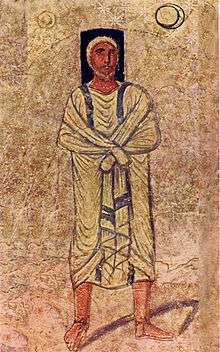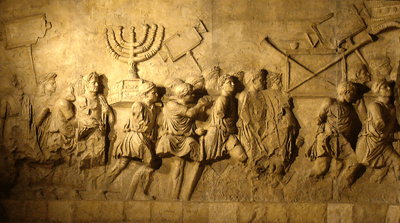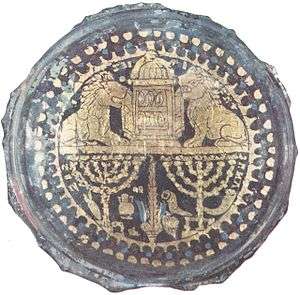History of the Jews in the Roman Empire
The history of the Jews in the Roman Empire traces the interaction of Jews and Romans during the period of the Roman Empire (27 BCE – CE 476). Their cultures began to overlap in the centuries just before the Christian Era. Jews, as part of the Jewish diaspora, migrated to Rome and Roman Europe from the Land of Israel, Asia Minor, Babylon and Alexandria in response to economic hardship and incessant warfare over the land of Israel between the Ptolemaic and Seleucid empires. In Rome, Jewish communities enjoyed privileges and thrived economically, becoming a significant part of the Empire's population (perhaps as much as ten percent).[1]

The Roman general Pompey in his eastern campaign established Roman Syria in 64 BCE and conquered Jerusalem shortly after, in 63 BCE. Julius Caesar conquered Alexandria c. 47 BCE and defeated Pompey in 45 BCE. Under Julius Caesar, Judaism was officially recognised as a legal religion, a policy followed by the first Roman emperor, Augustus. The ruling Hasmonean dynasty was deposed by the Romans after the Roman Senate declared Herod the Great "King of the Jews" in c. 40 BCE, the Roman province of Egypt was established in 30 BCE, and Judea proper, Samaria and Idumea (biblical Edom) became the Roman province of Iudaea in 6 CE. Jewish–Roman tensions resulted in several Jewish–Roman wars, 66–135 CE, which resulted in the destruction of Jerusalem and the Second Temple and institution of the Jewish Tax in 70 and Hadrian's attempt to create a new Roman colony named Aelia Capitolina c. 130.
Around this time, Christianity developed from Second Temple Judaism. In 313, Constantine and Licinius issued the Edict of Milan giving official recognition to Christianity as a legal religion. Constantine the Great moved the Roman capital from Rome to Constantinople ('New Rome') c. 330, sometimes considered the start of the Byzantine Empire, and with the Edict of Thessalonica in 380, Christianity became the state church of the Roman Empire. The Christian emperors persecuted their Jewish subjects and restricted their rights.[1]
Jews in Rome
_Cropped.jpg)
According to the Jewish Encyclopedia article on Rome:[2]
Jews have lived in Rome for over 2,000 years, longer than in any other European city. They originally went there from Alexandria, drawn by the lively commercial intercourse between those two cities. They may even have established a community there as early as the second pre-Christian century, for in the year 139 BCE, the pretor Hispanus issued a decree expelling all Jews who were not Italian citizens.
The Jewish Encyclopedia connects the two civil wars raging during the last decades of the first century BCE: one in Judea between the two Hasmonean brothers Hyrcanus II and Aristobulus II and one in the Roman republic between Julius Caesar and Pompey, and describes the evolution of the Jewish population in Rome:
... the Jewish community in Rome grew very rapidly. The Jews who were taken to Rome as prisoners were either ransomed by their coreligionists or set free by their Roman masters, who found their peculiar custom obnoxious. They settled as traders on the right bank of the Tiber, and thus originated the Jewish quarter in Rome.
Even before Rome annexed Judea as a province, the Romans had interacted with Jews from their diasporas settled in Rome for a century and a half. Many cities of the Roman provinces in the eastern Mediterranean contained very large Jewish communities, dispersed from the time of the sixth century BCE.[3]
Rome's involvement in the Eastern Mediterranean dated from 63 BCE, following the end of the Third Mithridatic War, when Rome made Syria a province. After the defeat of Mithridates VI of Pontus, the proconsul Pompeius Magnus (Pompey the Great) remained to secure the area, including a visit to the Jerusalem Temple. The former king Hyrcanus II was confirmed as ethnarch of the Jews by Julius Caesar in 48 BC.[4] In 37 BC, the Herodian Kingdom was established as a Roman client kingdom and in 6 CE parts became a province of the Roman Empire, named Iudaea Province.[5]
In the Greek cities in the east of the Roman empire, tensions often arose between the Greek and Jewish populations. Writing around 90 CE, the Jewish author Josephus cited decrees by Julius Caesar, Mark Antony, Augustus and Claudius, granting Jewish communities with a number of rights.[6] Central privileges included the right to be exempted from polis religious rituals and the permission "to follow their ancestral laws, customs and religion". Jews were also exempted from military service and the provision of Roman troops.[7] Contrary to what Josephus wants his readers to believe, the Jews did not have the status of religio licita (permitted religion) as this status did not exist in the Roman empire, nor were all Roman decrees concerning the Jews positive. Instead, the regulations were made as a response to individual requests to the emperor. The decrees were deployed by Josephus "as instruments in an ongoing political struggle for status".[8]
Because of their one-sided viewpoint, the authenticity of the decrees has been questioned many times, but they are now thought to be largely authentic.[9][10][11][12] Still, Josephus gave only one side of the story by leaving out negative decisions and pretending that the rulings were universal.[13] This way, he carried out an ideological message showing that the Romans allowed the Jews to carry out their own customs and rituals; the Jews were protected in the past and were still protected by these decisions in his own time.
The financial crisis under Caligula (37–41 CE) has been proposed as the "first open break between Rome and the Jews", even though problems were already evident during the Census of Quirinius in 6 CE and under Sejanus (before 31 CE).[14]
Jewish–Roman wars

In 66 CE, the First Jewish–Roman War began. The revolt was put down by the future Roman emperors Vespasian and Titus. In the Siege of Jerusalem in 70 CE, the Romans destroyed much of the Temple in Jerusalem and, according to some accounts, plundered artifacts from the Temple, such as the Menorah. Jews continued to live in their land in significant numbers, the Kitos War of 115-117 notwithstanding, until Julius Severus ravaged Judea while putting down the Bar Kokhba revolt of 132–136. 985 villages were destroyed and most of the Jewish population of central Judaea was essentially wiped out – killed, sold into slavery, or forced to flee.[15] Banished from Jerusalem, which was renamed Aelia Capitolina, the Jewish population now centered on Galilee,[16] initially at Yavneh.
After the Jewish-Roman wars (66–135), Hadrian changed the name of Iudaea province to Syria Palaestina and Jerusalem to Aelia Capitolina in an attempt to erase the historical ties of the Jewish people to the region.[17] In addition, after 70, Jews and Jewish Proselytes were only allowed to practice their religion if they paid the Jewish tax, and after 135 were barred from Jerusalem except for the day of Tisha B'Av.
The Diaspora

Many of the Judaean Jews were sold into slavery[18] while others became citizens of other parts of the Roman Empire. The book of Acts in the New Testament, as well as other Pauline texts, make frequent reference to the large populations of Hellenised Jews in the cities of the Roman world. These Hellenised Jews were only affected by the diaspora in its spiritual sense, absorbing the feeling of loss and homelessness which became a cornerstone of the Jewish faith, much supported by persecutions in various parts of the world. The policy towards proselytization and conversion to Judaism, which spread the Jewish religion throughout Hellenistic civilization, seems to have ended with the wars against the Romans and the following reconstruction of Jewish values for the post-Temple era.
Of critical importance to the reshaping of Jewish tradition from the Temple-based religion to the traditions of the Diaspora, was the development of the interpretations of the Torah found in the Mishnah and Talmud.
Late Roman period
In spite of the failure of the Bar Kokhba revolt, Jews remained in the land of Israel in significant numbers. The Jews who remained there went through numerous experiences and armed conflicts against consecutive occupiers of the Land. Some of the most famous and important Jewish texts were composed in Israeli cities at this time. The Jerusalem Talmud, the completion of the Mishnah and the system of niqqud are examples.
In this period the tannaim and amoraim were active rabbis who organized and debated the Jewish oral law. A major catalyst in Palestinian Judaism is Judah haNasi, who was a wealthy rabbi and one of the last tannaim, oral interpreters of the Law. He was in good standing with Roman authority figures, which aided in his ascent to being the Patriarch of the Jewish community in Palestine. The decisions of the tannaim are contained in the Mishnah, Beraita, Tosefta, and various Midrash compilations. The Mishnah was completed shortly after 200 CE, probably by Judah haNasi. The commentaries of the amoraim upon the Mishnah are compiled in the Jerusalem Talmud, which was completed around 400 CE, probably in Tiberias.
In 351, the Jewish population in Sepphoris, under the leadership of Patricius, started a revolt against the rule of Constantius Gallus, brother-in-law of Emperor Constantius II. The revolt was eventually subdued by Gallus' general, Ursicinus.
According to tradition, in 359 Hillel II created the Hebrew calendar, which is a lunisolar calendar based on math rather than observation. Until then, the entire Jewish community outside the land of Israel depended on the observational calendar sanctioned by the Sanhedrin; this was necessary for the proper observance of the Jewish holy days. However, danger threatened the participants in that sanction and the messengers who communicated their decisions to distant communities. As the religious persecutions continued, Hillel determined to provide an authorized calendar for all time to come that was not dependent on observation at Jerusalem.
Julian, the only emperor to reject Christianity after the conversion of Constantine, allowed the Jews to return to "holy Jerusalem which you have for many years longed to see rebuilt" and to rebuild the Temple. However Julian was killed in battle on 26 June 363 in his failed campaign against the Sassanid Empire, and the Third Temple was not rebuilt at that time.
During the Byzantine–Sasanian War of 602–628 many Jews sided against the Eastern Roman Empire in the Jewish revolt against Heraclius, which successfully assisted the invading Persian Sassanids in conquering all of Roman Egypt and Syria. In reaction to this further anti-Jewish measures were enacted throughout the Eastern Roman realm and as far away as Merovingian France.[19] Soon thereafter, 634, the Muslim conquests began, during which many Jews initially rose up again against their Eastern Roman rulers.[20]
Dispersion of the Jews in the Roman Empire

Following the 1st-century Great Revolt and the 2nd-century Bar Kokhba revolt, the destruction of Judea exerted a decisive influence upon the dispersion of the Jewish people throughout the world, as the center of worship shifted from the Temple to Rabbinic authority.
Some Jews were sold as slaves or transported as captives after the fall of Judea, others joined the existing diaspora, while still others remained in Judea and began work on the Jerusalem Talmud. The Jews in the diaspora were generally accepted into the Roman Empire, but with the rise of Christianity, restrictions grew. Forced expulsions and persecution resulted in substantial shifts in the international centers of Jewish life to which far-flung communities often looked, although not always unified, due to the Jewish people's dispersion itself. Jewish communities were thereby largely expelled from Judea and sent to various Roman provinces in the Middle East, Europe and North Africa. The Roman Jewry came to develop a character associated with the urban middle class in the modern age.[21]
See also
| Library resources about yes |
- History of the Jews
- History of the Jews in the Byzantine Empire
- History of the Jews in Egypt
- History of the Jews in Italy
- History of the Jews in the Land of Israel
- History of the Jews in Syria
References
- Barraclough, Geoffrey, ed. (1981) [1978]. Spectrum–Times Atlas van de Wereldgeschiedenis [The Times Atlas of World History] (in Dutch). Het Spectrum. pp. 102–103.
- Jewish Encyclopedia: Rome: Early Settlement in Rome
- E. Mary Smallwood (2001). The Jews Under Roman Rule: From Pompey to Diocletian : a Study in Political Relations. BRILL. pp. 120–. ISBN 0-391-04155-X.
- Jos., AJ XIV 190-195.
- Benjamin Isaac The Near East under Roman Rule: Selected Papers (Leiden: Brill 1998).
- Jos., AJ XIV 185-267; 301-323; XVI 160-178; XIX 278-311.
- Jos., AJ XIV 228.
- Rajak, Tessa (2007), 'Document and Rhetoric in Josephus: Revisiting the "Charter" for the Jews', in: Shaye J. D. Cohen and Joshua J. Schwartz (eds.), Studies in Josephus and the Varieties of Ancient Judaism Louis H. Feldman Jubilee Volume (Leiden: Brill), p. 178. ISBN 9789004153899.
- Rajak, Tessa (1984). "Was There a Roman Charter for the Jews?". The Journal of Roman Studies. 74: 109. doi:10.2307/299011.
- Pucci Ben Zeev, Maria (1994). "Marcus Antonius, Publius Dolabella and the Jews". Athenaeum. 82: 31.
- Rajak, Tessa (2007), 'Document and Rhetoric in Josephus: Revisiting the "Charter" for the Jews', in: Shaye J. D. Cohen and Joshua J. Schwartz (eds.), Studies in Josephus and the Varieties of Ancient Judaism Louis H. Feldman Jubilee Volume (Leiden: Brill), p. 178. ISBN 9789004153899.
- Except for: Moehring, Horst R. (1975), 'The Acta pro Judaeis in the Antiquities of Flavius Josephus', in: Jacob Neusner (ed.), Christianity, Judaism and Other Greco-Roman Cults 3:124–58 (Leiden: Brill).
- Rajak, Tessa (1984), "Was There a Roman Charter for the Jews?", The Journal of Roman Studies. 74:p.123. doi:10.2307/299011.
- H.H. Ben-Sasson, A History of the Jewish People, Harvard University Press, 1976, ISBN 0-674-39731-2, The Crisis Under Gaius Caligula, pages 254-256: "The reign of Gaius Caligula (37-41 CE) witnessed the first open break between the Jews and the Julio-Claudian empire. Until then – if one accepts Sejanus' heyday and the trouble caused by the census after Archelaus' banishment – there was usually an atmosphere of understanding between the Jews and the empire ... These relations deteriorated seriously during Caligula's reign, and, though after his death the peace was outwardly re-established, considerable bitterness remained on both sides. ... Caligula ordered that a golden statue of himself be set up in the Temple in Jerusalem. ... Only Caligula's death, at the hands of Roman conspirators (41), prevented the outbreak of a Jewish-Roman war that might well have spread to the entire East."
- Jewish Encyclopedia: BAR KOKBA AND BAR KOKBA WAR: Publius Marcellus: "...and thus about fifty strongholds and 985 undefended towns and villages fell into their hands (Dio Cassius, lxix. 14)."
- Jewish Encyclopedia: Galilee: "After the fall of the Jewish state a new period of prosperity set in for Galilee; and it gradually became the center of Jewish life in Palestine."
- H.H. Ben-Sasson, A History of the Jewish People, Harvard University Press, 1976, ISBN 0-674-39731-2, page 334: "In an effort to wipe out all memory of the bond between the Jews and the land, Hadrian changed the name of the province from Iudaea to Syria-Palestina, a name that became common in non-Jewish literature."
- http://www.jewishpress.com/sections/books/a-jewish-slave-in-rome/2017/07/24/
- Abrahamson et al. The Persian conquest of Jerusalem in 614 compared with Islamic conquest of 638.
- Rosenwein, Barbara H. (2004). A Short History of the Middle Ages. Ontario. pp. 71–72. ISBN 1-55111-290-6.
- K. R. Stow (1 September 1995). The Jews in Rome: The Roman Jew. BRILL. pp. 17–. ISBN 90-04-10463-1.
Further reading
- Barclay, John M. G. 1996. Jews in the Mediterranean Diaspora from Alexander to Trajan (323 B.C.E.–117 C.E.). Edinburgh: T. & T. Clark.
- Goodman, Martin. 2000. State and Society in Roman Galilee, A.D. 132–212. London and Portland, OR: Vallentine Mitchell.
- Goodman, M. 2004. "Trajan and the Origins of Roman Hostility to the Jews." Past & Present 182: 3-29.
- Mclaren, James S. 2013. "The Jews in Rome during the Flavian Period." Antichthon 47:156-172.
- Pucci Ben Zeev, Miriam. 1998. Jewish Rights in the Roman World: The Greek and Roman Documents Quoted by Josephus Flavius. Tübingen, Germany: Mohr.
- Rutgers, Leonard Victor. 2000. The Jews in Late Ancient Rome: Evidence of Cultural Interaction in the Roman Diaspora. Leiden, The Netherlands: Brill.
- Schürer, Emil. 1973. The History of the Jewish People in the Time of Jesus Christ (175 B.C.–135 A.D.). Revised and edited by Emil Schürer, Géza Vermès, Fergus Millar, Matthew Black, and Martin Goodman. 2 vols. Edinburgh: T. & T. Clark.
- Smallwood, E. Mary. 1976. The Jews under Roman Rule. Leiden, The Netherlands: Brill.
- Stern, Menahem, ed. 1974. Greek and Latin Authors on Jews and Judaism. 3 vols. Jerusalem: Israel Academy of Sciences and Humanities.
- Varhelyi, Zsuzsanna. 2000. "Jews in Civic Life under the Roman Empire." Acta antiqua Academiae Scientiarum Hungaricae 40.1/4:471-478.
- Weitzmann, Kurt, ed. 1979. Age of Spirituality: Late Antique and Early Christian Art, Third to Seventh Century. New York: The Museum.
